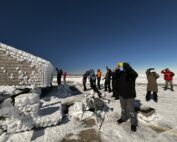Solar Eclipse 2024: A Celestial Wonder
By Ryan Knapp
As you might have heard through social media, the news, magazines, friends, family, etc., a solar eclipse is about to be viewable across North America. This rare and awe-inspiring phenomenon will take place on April 8, 2024, with the path of totality sweeping through New England.
What is a Solar Eclipse?
A solar eclipse occurs when the Moon’s orbit intersects the Earth’s orbital plane. During this alignment, the Moon casts its shadow on the Earth’s surface, creating a region of darkness. The eclipse’s totality, where the Moon completely blocks the Sun, is only visible within a narrow path known as the path of totality. A partial solar eclipse, where the Moon obscures only a portion of the Sun, is visible outside this path.
Safety Precautions
While solar eclipses are beautiful and fascinating, taking safety precautions to protect your eyes is crucial. Looking directly at the Sun during a solar eclipse can cause permanent damage to the retina. Therefore, it is essential to use certified solar eclipse glasses or solar filters to view the eclipse safely. And a word of advice – purchase viewing glasses ASAP online or at a local reputable retailer, as it is highly improbable you will be able to find a pair on the day of the event. If you cannot locate viewing glasses or do not want to spend $1 to $3 for a pair, consider making a shoebox solar eclipse viewer.
How to Prepare for the Eclipse
Planning ahead is advisable to make the most of the upcoming solar eclipse. Here are a few tips for consideration:
- Check the path of totality: Determine whether your location falls within the path of totality or if you need to travel to a viewing area within the path.
- Get the proper safety gear: Purchase certified solar eclipse glasses or solar filters to protect your eyes and camera gear.
- Arrive early: Arrive at your viewing location well in advance to secure a good spot and thus avoid being stuck in traffic, losing a parking spot, and avoiding overcrowded areas.
- Be patient: Solar eclipses are relatively brief events, so be patient and enjoy the moment.
- Plan your viewing location: Choose a safe area with a clear view of the Sun.
Other Considerations
- Plan for traffic congestion the weekend before and all day Monday, April 8, 2024, especially after the eclipse when people leave simultaneously.
- Reschedule non-urgent appointments for a different day.
- Get gas and groceries and run errands before the eclipse day.
When will it be viewable?
The timing of the solar eclipse will vary depending on your location. You can check out websites like timeanddate.com to determine when the eclipse will begin and end at your location. For the summit of Mt. Washington, the eclipse starts on Monday, April 8, 2024, at 1416 EDT, max out at 1529 EDT, and conclude at 1638 EDT (see table below for the complete timeline).

Solar eclipse timeline for the summit of Mount Washington, NH
How about Mt Washington as a viewing location?
If Mt Washington or another summit in the White Mountains is a location you are aiming for to view the upcoming eclipse, here are a few things to consider:
- The summit of Mt. Washington and most of the White Mountains will not be in the path of totality. If you think, “Well, 99% coverage is good enough,” it is not; the contrast will be night and day. Since we will not be in the path of totality, you must keep your viewing glasses on at all times, and with said glasses off, the Sun will only be slightly dimmer but still appear bright, and through an unfiltered camera lens, you will not see a thing. Night will not fall, and you will not see stars/planets (or the possible comet). The temperature drop will not be as dramatic. The corona won’t be visible. You will not get a 360º sunrise/set. The effects on nature (like birds stopping singing) are not as noticeable, if at all. If you must be on a summit, aim for one of the peaks in the Adirondacks, Green Mountains, or far northern White Mountains of NH/ME that will be in the path of totality.
- There is a high probability that the solar eclipse will not be visible due to clouds/fog. Many outlets have published maps of viewing probability based on cloud coverage in the past for that date. Northern New Hampshire generally has a low likelihood of viewing, with most maps I have seen putting the region in the 80% to 90% range of clouds obscuring the view. See the links below for additional details:
insert:
https://www.weather.gov/car/2024TotalSolarEclipse
https://www.weather.gov/btv/eclipse2024
https://www.ncei.noaa.gov/news/take-your-head-out-clouds-view-2024-total-solar-eclipse
https://storymaps.arcgis.com/stories/e7d0e4cef5044ecfaa54f44ac61de81e
https://eclipsophile.com/2024tse/
The summit is in the clouds (fog) over 60% of the year, so before even digging into our data, I know the odds are not in our favor. Digging into our data even deeper, the statistical likelihood of seeing anything is low. I first looked at the sky/weather conditions for the three hours the eclipse will occur at our location (1400 EDT to 1700 EDT). I then dug deeper, examined the sunshine minutes for each of those hours from 1935 (when sunshine minutes were consistently recorded) to the present, and then color-coded them accordingly. As you can see, there is a lot of red (0 minutes) and very few green (46-60 minutes).
Past weather and sunshine minutes for April 8th on the summit of Mt Washington, NH
- Viewing probability aside, the weather in early April should be considered for viewing/photographing. The normal temperature for April 8 is 20°F. The record high for the date is 50°F (1991), and the record low is -6°F (1977). The average monthly wind speed is 35.6 mph, with the record peak gust for the month being 231 mph. The month averages 33.1 inches of snowfall. As you can see in the weather matrix I created, the date can see various weather like fog, blowing snow, snow, sleet, hail, rain, and even thunderstorms. It is too early to say what the weather will be like in 2024, but if the past is any indicator, it is likely to be foggy, cold, and windy. Time will tell, but as the date approaches, you can check out our 48-hour Higher Summits Forecast.
- If you choose a higher summit, know you are committed to that location for better or worse. Depending on distance, weather, trail conditions, your abilities, etc, hiking to a summit can take time. That might mean leaving in the morning to arrive at your location on time in the afternoon. That also means you might not see or photograph the eclipse if clouds roll in, fog develops, wind increases, etc. If clouds are rolling in and you can access a car, you might look at satellite maps and try to drive to a clearer location in time. But if you are out on foot, miles away from a vehicle, if the weather turns, you have little to no options to adjust and might miss viewing it.
- If Mt Washington is the goal, note that all summit facilities will still be closed for the winter on that date, and no shelter is available.
Related Activities MWOBS is Hosting
Mount Washington Observatory will be hosting a few events related to the eclipse on the days leading up to and on eclipse day, including numerous distance learning opportunities geared toward the history and science of eclipses plus viewing tips, an exhibit of MWOBS astrophotography at the Omni Mount Washington Resort, a community science program in Pittsburg, NH in collaboration with Citizen Continental-America Telescope Eclipse, and more! For a complete list of available options we will be providing, please check out 2024 Total Solar Eclipse page. We hope you can join us for some or all of our scheduled events.
Conclusion
The upcoming solar eclipse is a rare and extraordinary celestial event that should not be missed. The path of totality will have the best overall experience. Suppose you do not live in or cannot travel to the path of totality. In that case, the partial solar eclipse that is viewable to the rest of us will still be an enjoyable experience, so long as the weather cooperates. As of this writing, we are less than a month away, so now is the perfect time to start planning and making proper preparations so that you can safely enjoy this awe-inspiring spectacle and create lasting memories.

The view of the Solar Eclipse from Mt Washington on August 21, 2017
2024 Total Solar Eclipse: Two Perspectives
2024 Total Solar Eclipse: Two Perspectives By Karl Philippoff and Francis Tarasiewicz Mount Washington, New Hampshire (Francis) I got into meteorology in part, because of how the weather can, even if briefly, bring us
From Mount Washington to Antarctica
From Mount Washington to Antarctica By Charlotte Markey What do Antarctica and the summit of Mount Washington have in common besides weather? Having worked as support staff for both locations, I can tell you
Mount Washington Observatory to Host 90th Anniversary Big Wind Day Celebration
Mount Washington Observatory to Host 90th Anniversary Big Wind Day Celebration North Conway, NH – March 23, 2024 – In commemoration of the 90th anniversary of the highest wind speed ever recorded at a



